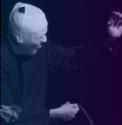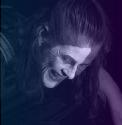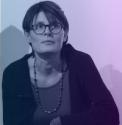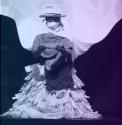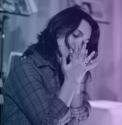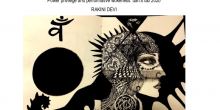Performance and the Pandemic by Dr. Rakini Devi
Power privilege and performative wokeness: dan:s lab 2020 RAKINI DEVI
This paper was comissioned by Critical Path, Sydney, after an online seminar titled dan:s lab. It is my response to the woprkshops, discussions and exchanges with artists and academics from Singapore who initiated it, Australia, India, Taiwan, Hong Kong and Manila.
During the four day seminar, I sketched diagrams and images as is my usual practice when taking notes.
Response to the Abstract
"We need art only to the extent that life dehumanises us, we need art to survive", was the response given by the dynamic and subversive Indian choreographer, activist, and feminist, Chandralekha (b. 1928 - 2006), who manipulated the structures of sacred dance into contextually secular interpretation. She asked: Why dance? What does it mean to dance? Many dance artists like Chandralekha experienced extreme hardships, fighting to sustain their practice in spite of disadvantages in their socio-economic, political, cultural, and misogynistic circumstances for decades, in what she describes as a constant hostile environment. Like many dancers during the current pandemic, isolated and disconnected, Chandralekha interrogated her practice, asking: Can dance/art save me? My own answer to that question is, without hesitation, most definitely. I cannot imagine a life without art, which is for me, a vital form of sustenance.
The hostile environment of the ongoing pandemic has illuminated the precarious nature of the artist's plight, a condition already plagued by its own pre-pandemic chronic illnesses. The complex issues of sustaining a dance life, aside from financial support, is dependent on physical and mental well-being in order to maintain a stressful level of " relentless productive output," that has weighed heavily on us during isolation. From my own experience and contact with my colleagues in India, Europe and the US, I discovered that the pandemic-induced pressure to remain relevant, competitive, and strong has proved to be an added challenge for many, while battling loss of income, closures of borders and venues, and requiring an altogether new form of virtual stamina.
The language of dance operates on several layers of abstraction and psychological complexity, containing its own logic and ability to reshape the systems that form our practice. As dancers who have struggled with socio-economic challenges throughout our careers, have we not the creative tools to facilitate the regeneration of the mechanisms of revival and resilience? We have, through our dancing bodies, created fleeting moments of art that now, through technology, we can capture and explore within visual territories, infusing the act of dancing, both a performative and technologised event, with the potential to generate new partnerships and "to foster interdependent networks of solidarity across borders", countries, and cultures like never before.
As a researcher who has spent an entire career interrogating various possibilities and methods of embodiment, the pandemic has created an opportunity to forge new connections and learn new skills of communication. Exploring a pathway through this new reality can hopefully generate positivity for younger generations to come, presenting an opportunity to re-define the relationship between the individuals' mind/body, and connecting them to diverse cultures and communities. These explorations of new virtual platforms will impact on how we choreograph dance in the future. My interest in dan:s lab is to contribute to the debate on how the corporeal and virtual merge to develop work across time frames and global audiences.
Response to the four -day laboratory
During the four- day lab, working between typing, handwriting, and drawing in my journal, I noted the diverse and dynamic conversations across the participating countries and recorded these and my own responses within these exchanges. The present text is not a documentation of the lab in chronological order. It is a personal sharing of the insights and provocations of specific moments, actions, and rhetoric that ignited my interest. The paper is a collage of these fragments, structured like a choreographic score, composed as a series of movements, steps, traces, pauses, arcs of movement and breath. The sketches are a personal method of listening and concentrating on the discussions throughout the four days. Below are some of the keywords and phrases that triggered dialogue between participants. In no particular order, they are:
Digital architecture Co-immunity Occupy erasure Absences
Social solidarity
Anti body as antidote
Chinese medicine
Balancing
Not ill
Black Hole
Touch will be a paradigm
Counter erasure
Intimacy trust
Authenticity
Conflict zones
What is privilege?
Politics of breath
Social choreographies
Enforced acts of hiding and covering Desire can be a framework
Naming is reclaiming Place_space_race
Performative wokeness
Upper class feminism
Erasure as autoimmune disease Identity construct
Witnessing as knowledge
Shifting the blame
Environment as resource
Invisible body
Breath as score
Day one: Diagnosis
On the first day of the lab, the dialogue between the participants centred on identifying the diverse range of symptoms that have impacted on our dancing/performing "Covid- bodies". The collective diagnosis of our already flawed and chronically ill system revealed that every aspect of pre-Covid life has been brought into sharp focus with the onset of the global pandemic. Many responded to Tang Fu Quen's keynote presentation and his explanation of the term umwelt1 as metaphor for the brief of the lab. We were inspired by this term in the context of the new realities of a Covid-impacted world. Key topics of debate included: how can we thrive within this new diseased environment? How does the Covid body move and survive? How do we dismantle the disparities of resources and hierarchical pressures that affect us disproportionately? How do we chart a course of action whilst gripped with fear, isolation, and a general sense of malady? After months of many of us being in lockdown and quarantined, our collective enforced retreat gave us a sense of urgency, and a desperate need to share and exchange our responses. Between the passionate outpouring of suggestions there was also a continuous flow of links to specific articles and books that highlighted or resonated with certain arguments.
One of several interesting reading suggestions was Susan Sontag's Illness as Metaphor (1977).
Illness is the night-side of life, a more onerous citizenship, in the kingdom of the well and in the kingdom of the sick........ Yet it is hardly possible to take up one's residence in the kingdom of the ill unprejudiced by the lurid metaphors with which it has been landscaped.
Susan Sontag 1977 Illness as Metaphor.
There have been many criticisms and arguments for and against Sontag's view that metaphors can render illness and diseases (for example tuberculosis and cancer) socially and physically humiliating. However, in keeping within the context of dan:s lab's brief, I am drawn to her framing metaphor of the dual kingdoms we inhabit, the healthy and the ill, since it resonates with our current condition, of transitioning into or threatened by the encroachments of the latter. Suddenly over a matter of weeks our lives as we knew it had changed. We have no choice other than to explore remedies and treatments for us to survive under this new sovereignty of Covid in our world, the domination of which has been revealed by catastrophic disruptions, including the domino effect of the virus, which threaten all that we value and cherish.
Amidst the collapse of economies on a global scale not experienced since the Spanish Influenza (February 1918 – April 1920), the insidious scope of human greed, cruelty and neglect unfolds itself into view, exposing vast chasms between social classes and social bodies. The term co- immunity was widely used during dan:s lab discussions, in the context of the positive role that communities can play, at a time when it appears that the privileged seem more "immune" to the more brutal impact of the virus. In conversation with my colleague, the Mexican performance artist /activist Guillermo Gomez Pena, we voiced the fact that isolation is a privilege. Living in cities far from the countries of our birth (Mexico and India respectively), we are aware of our own privilege of being able to isolate in the security of our artistic environments, while so many communities cannot afford the luxury of isolation or distancing. To add to our general fear of the unknown, many independent artists who live precariously at the best of times have become invisible. Art and artists have been rendered expendable during the pandemic (see Fig.2), in spite of the unprecedented downloading of movies, music, live streaming of performances, and regardless of the contribution of art to the nations' tourism and work force.
To resist and object to these attitudes, we as artists have sought to explore the potential to thrive and operate within a possible ecology of care. It can begin in discussions such as this lab, that may not have answers, solutions or magical antidotes, but as we enter this virtual portal, it gives us a sense of co-immunity, of shared virtual spaces, and insight into each other's lives and homes never before dreamt as a “new normal.” Through actions and encounters that have been driven by this common goal, we ask: How to dance when we are ill?
Day two: The Clinics and Prognosis
The second day saw us whisked into different breakout meeting rooms in groups of four to five participants from different countries. Our task was to respond to the "diagnosis" from day one. I was selected to join two clinics that addressed the same topics addressed by the Indian participants, whose contributions were strongly presented by facilitator Ranjana Dave. My placement within two groups, examining the same set of provocations invoked a deeper interaction with these debates. I was particularly engaged with the issues Indian artists faced, not only because of my personal lifelong ties with the country of my birth, but due to my three - decade research into and practice of socially aware performance with reference to India's social and political issues. During these discussions, there were live Google docs and a whiteboard that participants could use to add comments, links to articles or videos, or message each other. I share some of these comments as an example of the dynamics of the dialogue.
INDIA: Whiteboard notes and comments
-
Body as watery embodiment, in which case, the skin becomes a permeable membrane, its sweat, vapours (through breath) and blood embodying the potential to create disruptive solidarities.
-
Water becomes an entry-point to thinking about health, illness, proximity and categories.
-
Thinking about shrinking spaces (both physical and socio-political) engineered by institutional regulations.
-
Touch as both threatening and gratifying at this moment.
-
The body becomes invisible in the lack of acknowledgment, registered instead as a
spectral residue on the digital surface.
-
Emphasis on the “liveness” of the skin and breath- no mediating technologies yet to
simulate them.
-
Skin and breath as embodied archives of health and presence.
-
One could think through the ‘anti-body’ as that which goes beyond notions of the physical, digital, virtual or immunological, to become a resistant ‘body’.
-
Is the anti-body more visible in its subversive power to think outside extant paradigms?
-
The anti-body is supposed to neutralize the invasive virus following which the body develops an adaptive response. What if we were to extend the ontology of the anti-body to mean an archive of strategies of resistance against omission/invisibility?
-
Is the anti-body an anodyne to the systemically broken body? An ideal to be aspired to and draw from when the fissures of the ‘body’ are too stark? The anti-body could be digital because this medium (the screen) is immune to the virus.
-
A digital archive of resistance and information?
-
Instead of skin and breath, the digital interface could mobilise an affective sensorium of
voices.
-
The digital anti-body is beyond complete annihilation/death; it can only mutate in form and content. It has no hierarchies and can be imagined as a pool of “oceanic eddies”.
-
Mobilising archives - drawing on personal depositories of memories.
-
Platform of Lab offering perspective and experiences of lived bodies in a time when the
body has disappeared from its ‘normal’ routine.
-
Omission from a space also implies opening up possibilities of occupying a new
space/scenario.
-
There is resilience in communities and peoples who have been denied access/space to
create new spaces of expression.
-
Embodying Omission - being present in a space as representation.
-
Denial of access to one group, led to access to many other (spaces and opportunities)
-
How do we begin to claim space in non-invasive ways, where our space doesn’t
impinge on the rights of others?
-
Marginalized communities as resilient communities - finding new spaces to occupy.
-
The Body as Archive - Rakini (AU). How can we draw upon histories and representation
to look at staging bodies as protest?
In our Covid-impacted worlds, consumerism and capitalism have also infected what Tang Fu Quen suggested was the "machinery of culture," inseparable from economy and politics globally. For example, Stephen Wright's article Militant care in a time of atrocity (2020), was a timely read during the week. His observations resonated with the discussions in relation to hierarchies, privilege, and the disparities of resources between the various participating countries of dan:s lab. Many discussions centred on what "space" means in different cultures. It also reinforced my personal refection during the lockdown, by illustrating the corrupting forces identified by capitalism:
Everything we know and are comforted by has been made possible by capitalism’s unparalleled devouring of flesh and blood, its stratification of humanity and its relentless obliteration of the natural world.
Wright's article elaborates on the theory of psychological ‘doubling’ as a term to describe how Nazi doctors and perpetrators of the Holocaust were able to justify their actions by using the joint actions of ‘psychic numbing and denial’. This approach convinced them of the rationality of the atrocities they proceeded to commit. Though comparisons with Nazi Germany may seem extreme, complacency and self -serving attitudes supporting the pre-pandemic concept of normality have led, in part, to the state of extremity that we currently face.
Wright likens historical attitudes to modern White Australia's response to issues of race, immigration, the arts, and minorities.
White Australia mutates into callousness... it has traditionally been a nation of people saturated in psychic numbing and denial – people who occasionally behave in ways that could be called altruistic, but are otherwise happy to enable the project of white domination. And still are. For white Australians, the very borders of our subjectivity are the borders established by white supremacy. And borders are now desperately, paranoidly significant in the white Australian project.
Stephen Wright 2020
Our discussions centred on identifying the ways of nursing into being a new, vital reality of co-
immunity, a concept that has never before this time been so charged and urgent. Of particular interest to me was the notion of occupying the erasures and absences such as discussed by Ranjana Dave, who presented the metaphor of the "leaking body", representative of the absences, exclusions and erasures that have appeared in the collective body, and hitherto ignored or denied. The suggestion is that these vacant spaces or rifts in space can be inhabited, by embodying the ruptures and erasure created by the pandemic. In both clinics there was a strong sense of resistance and stress due to the additional sanctions and disadvantages they faced, due to their country's response to Covid 19. Class, caste, and privilege were keywords.
Another debate resulted in a strong critique of "performative wokeness", a term I describe as selective political correctness. For example, one of the links shared during the clinic was James Thompsons' essay, The Aesthetics of Care. The article explored arguments that debated the outcomes of many art projects that can potentially be seen as "forms of affective solidarity and mutual regard that, in turn, could be powerful counterweights to the exclusions and disregard in a careless society." (Thompson 2020).
Thompson's observation of a "careless society" has been heightened by the chaos and paranoia generated by the pandemic, giving rise to increasing racist atrocities and horrific neglect of disadvantaged communities across a global scale. It is obvious that class, colour, culture and financial status are defining factors of modern security and wellbeing. Thompson argues that it is imperative that we acknowledge that the idea of autonomy from these constraints and contexts is illusionary, and that it is merely convenient for the sake of an unacknowledged state of “order” for us to believe that all members of society enjoy freedoms equally, or entirely independent to our wider social worlds. The claim that we are relieved of the supposed burden of responsibilities beyond our lives is itself only theoretical, and is possibly more revealing of the internalised patterns of domination and submission that many have accepted unknowingly.
I define one aspect of privilege being the freedom of choice concerning the quality of forms of life, a freedom vastly unavailable to many populations. To illustrate that argument, I shared my recent reading of Arundhati Roy's The Pandemic is a Portal. It is a response to the brutal reality of the disparity of class and caste in India, and the atrocious treatment of its migrant workers at the outbreak of the virus. It is a sombre read, but is also an education lesson in how we might approach the re-building of new, and better, systems, acknowledging the fact that there is no return to our pre-pandemic lives.
Whatever it is, coronavirus has made the mighty kneel and brought the world to a halt like nothing else could. Our minds are still racing back and forth, longing for a return to “normality”, trying to stitch our future to our past and refusing to acknowledge the rupture. But the rupture exists. And in the midst of this terrible despair, it offers us a chance to rethink the doomsday machine we have built for ourselves. Nothing could be worse than a return to normality. Arundhati Roy, 2020.
Roy's descriptions of rupture were again echoed during our discourse on erasure and omissions, leading to ideal approaches to the notion of absence in places that we, as artists, both locally and globally, can occupy. Other topics of discussion centred on covid-related metaphors, creating new symbolic languages, for example immunology as an example of privilege/exemption, and the imageries of “germs" deployed by politicians to invoke paranoia and confusion in already distraught and diseased societies.
Racism, in view of the current BLM protests, was inevitably a strong topic of discussion, with many cynical or despairing. In non-US contexts, the movement reveals the hypocrisy of the privileged, the mobilisations of some of whom have been seen as prime examples of selective social outrage, in particular when “addressing” the Black Lives Matter urgency in the US, while remaining passive or silent regarding the continued atrocities on their own home soil. An Indian participant mentioned how Bollywood stars and celebrities supported the BLM protests via their social media platforms, whilst ignoring the plight of the starving migrants in their own country, being driven back on foot to their villages after being given six hours to leave the cities where they worked. People on our own home soil in Australia are wondering why it took an event in the US to address our own problems of systemic racism.
Below are some fragments of our dialogue on resilience, racial minorities, and why “performative wokeness” appears decorative:
Corrie: I guess I have an observation about another side of “resilience” that Joshua brought up earlier — in Singapore there’s been a burgeoning discussion about over- rewarding perceived “bravery” or “resilience” among racial minorities for putting up with constant and consistent marginalisation, and there’s been a shift to refuse the label or the congratulation of “resilience” because of the exhaustion that comes with trying to perpetually cultivate this resilience in the face of systemic racism.
The power of privilege to dictate construction of identity of minority: model minority, “exceptional” minority. Good Muslim vs. Bad Muslim.
Performativity of “wokeness”/protest - it becomes decorative. How are these performative acts of being “woke” endangering communities that are being oppressed/denied access?
Just as subversive cultures/communities are silenced or censored, there is a certain censure in mainstream/hegemonic/privileged communities with power in what they can’t/shouldn’t talk about - denial, tone policing, gas lighting...and expecting these minority communities to come up with the solution as well.
It was crucial to address the very uncomfortable topic of racism in the arts, especially during this forum, which urged us as individuals to interrogate our own motivation, complacency, and attitudes that we may have inadvertently contributed to contemporary situations. In our collective belief that we are socially aware, it is the dangerously self-congratulatory position implied by the concept and its expression that is also being questioned by the excessive currency of "wokeness" as “action.”
Steve Rose, in his article in The Guardian,
"How the word ‘woke’ was weaponised by the right" (2020), writes about the many detractors of this term, who are rejecting the word as a "signifier
of pretentiousness and cultural elitism". There will be many more terms that are derived from the now old and tired "politically correct" vocabulary of our claims to being socially aware, while the injustices of social and racial violence continue, largely unaffected by the on-trend language of our times.
Days three and four: Treatment and Rehabilitation
We continued our discourse on how we might address diagnosis, prognosis, treatment, and finally rehabilitation. One of the primary outcomes of our discussions is the acknowledgement of new responsibilities, which extend beyond the personal to a sense of connecting with local and global communities. These new responsibilities come with new fears that there may be policies or actions that may echo the social symptoms that plagued us before our society’s collective “infection” by the virus and its hold over our lives. For example, by acknowledging the disparity of resources and environments of different regions, we can ensure that future acts of solidarity do not exclude or impact on others negatively. The future of solidarity is ecological. These debates led to a strong criticism of analysing or treating social injustices, from feminism to intercultural debates on racism and oppression, from a purely Western perspective.
This is a valid fear of echoing past systemic illnesses, namely the self-aggrandising attitudes of intellectuals in academia or organisations who task themselves with speaking and acting for the disadvantaged or voiceless, with the assumption that they are solving issues, when in fact, they are rendering their subjects speechless (again). Some referenced Spivak's theories on the subaltern. Through her influential yet often- contentious essay, Can the Subaltern Speak? (1985) Spivak critiques the perspective of the Western intellectual’s view on topics of the historical experience of the underprivileged. These observations resonated with my doctoral thesis Urban Kali (2018), where I write about the Stereotypical "intercultural" body:
Of equal importance in my work is the necessity to address the prejudice faced by non- European artists, including cultural stereotyping, racial profiling, and cultural appropriation that distinguishes their experiences from Western feminist perspectives.
Devi, R 2018 Urban Kali, chapter 2.4 p.56
Spivak was my choice of theorist for my doctoral thesis "Urban Kali: From Sacred dance to secular performance," where I specifically declined to employ Western (mainly American) feminist theorists in my work, which has always been inspired by my Indian heritage and my Australian experience of making work. My choice of theorists and practitioners were mainly Indian and Australian. Particularly central in my consideration was Spivak’s delivery of this analysis: “The ventriloquism of the speaking subaltern is the left intellectual’s stock-in-trade” (2010, p. 27).
Spivak critiques academics who invest in the re-telling of stories of oppression, with an agenda of conflating their own research. Those who focus on the "pain narrative", which is another form of oppression, exemplify the entitlement of privilege, specifically in academia. By prescribing solutions and analysing only those stories and cases that appeal to them, and by using a selective approach to mainly sensational stories of pain inflicted on the "other", they can be seen as silencing the actual voices of the disadvantaged. I believe these cautions can be applied to all races, and avoid the over -used "De-colonise" that has prefaced many art projects. Oppression and enslavement is a global pandemic largely ignored by the privileged, composed of people from all races, religions, and colours.
Another suggested reading was '“We Have Rich Histories of Desire in India”: An Interview With Madhavi Menon.’ What I draw from this interview is the positive action to go forward in our rehabilitation and renewal into what is, so far, unknown territory. But caution must be taken in the process lest we revert to misguided acts of nostalgic renewal or revival, the naming or identifying of which is important but can be ambiguous. Naming as an act of reclamation is one of the most powerful actions that we, as a collective, can do as the first steps towards imagining a future, post-pandemic. Menon warns us though, that this "naming" can also be dangerous by creating acts of exclusion, the subject which arose numerous times in our debates on the problems of exclusivity and hierarchies within the arts. Menon interrogates the unanswered questions of desires that fall between the cracks.
The emphasis on naming is a very Western emphasis. I don’t mean this in a nationalistic
manner; I mean, rather, that we seem to be blindly following a script that has emerged from very different material circumstances in the West. Naming desires probably makes a lot of sense in many parts of the West because they have a history of silencing. Menon (2020).
In our passion to name, dissect, treat and construct policies and blueprints for our futures, we should tread cautiously, lest we fall into old patterns and systems that are, as we all agree, flawed, corrupt, and diseased. We collectively contributed to the potential for addressing the complex issues of analysing a transnational practice. Only by first identifying our own social functions, can we engage with others, or suggest antidotes. Some of the comments recorded were: What is a transnational practice? Collective Umwelt?
• In order to fulfil a wider civic role: “focus on the potential of art to transform people’s everyday lives, their sense of self, and places they live in”. If we don’t fulfil a wider civic role, will we eventually become extinct? And if so, should some parts of art just die this way? Death of some aspects of art, or maybe all of art, might also suggest rebirth.
Covid-19 has manifested as a destructive revelation of the accumulated chronic illnesses of society. The diverse global responses to the pandemic have revealed the institutionalised injustices of caste, class, religion and gender impacting disadvantaged communities. Where does dance or any performing art feature in the Covid-world? In the face of this predicament, there were many positive outcomes of dan:se lab. There was an unprecedented outpouring of collective care, determination and reflection in the context of structuring a future where we learn from our past, and educate ourselves in ways of how to move forward. As dancers and artists, our bodies are our resources, our bodily memories offering a spectrum of skills. Beyond rhetoric, beyond the limitations of touch, our diverse physicality affords us the potential to move forward, mindful of our digital footprints as we choreograph our new, unfolding realities.
The responses from the final wrap up included a shared vision of how we may build new pathways through the digital umwelt of online performance, mindful of maintaining a balance while dancing between two worlds. Shaped by the pandemic, we recognise our embodied skills in building our own immune systems to traverse these realms. By exploiting our bodies as archives, and using the permeable resources of skin and breath to collectively and collaboratively structure an eco-community, we can visualise the emergence of a new resilient post-pandemic-body. One that has been slowly transformed and adapted from the Covid-body to one that can bridge the virtual and real worlds with ease, and generating new relationships of touch. Most crucial to this transformation is our process of making visible the liveness of skin and breath, the vitality of the live-presence that is at the core of our practice.
Rakini Devi, Sydney 2020.
NB Once I have worked out how to upload images within this paper, I will add them. All comments welcome, Rakini.

